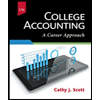
FINANCIAL+MANAG.ACCT.(LL)-W/ACCESS
9th Edition
ISBN: 9781264624829
Author: Wild
Publisher: MCG
expand_more
expand_more
format_list_bulleted
Question
Chapter 3, Problem 34QS
a.
To determine
Introduction:
To prepare: The journal entries for the given transactions follow the usual practice.
b.
To determine
Introduction:
Journal entries: The journal entries are prepared by the organization to record the daily transactions that are non-economic and economic. The ledger accounts are prepared based on the journal entries.
To prepare: The journal entries for the given transactions following the alternate practice.
Expert Solution & Answer
Want to see the full answer?
Check out a sample textbook solution
Students have asked these similar questions
Jazz Corporation owns 50 percent of the Vanderbilt Corporation stock. Vanderbilt distributed a $10,000 dividend to Jazz Corporation. Jazz Corporation's taxable income before the dividend was $100,000. What is the amount of Jazz's dividends received deduction on the dividend it received from Vanderbilt Corporation?
How can I solve this financial accounting problem using the appropriate financial process?
I am searching for the accurate solution to this general accounting problem with the right approach.
Chapter 3 Solutions
FINANCIAL+MANAG.ACCT.(LL)-W/ACCESS
Ch. 3 - Prob. 1QSCh. 3 - Computing accrual and cash income C1 In its first...Ch. 3 - Identifying accounting adjustments P1 Classify the...Ch. 3 - Prob. 4QSCh. 3 - Prepaid (deferred) expenses adjustments P1 For...Ch. 3 - Prepaid (deferred) expense adjustments P1 For each...Ch. 3 - Prob. 7QSCh. 3 - Prob. 8QSCh. 3 - Prob. 9QSCh. 3 - Prob. 10QS
Ch. 3 - Prob. 11QSCh. 3 - Prob. 12QSCh. 3 - Prob. 13QSCh. 3 - Prob. 14QSCh. 3 - Prob. 15QSCh. 3 - Prob. 16QSCh. 3 - Prob. 17QSCh. 3 - Prob. 18QSCh. 3 - Prob. 19QSCh. 3 - Prob. 20QSCh. 3 - Prob. 21QSCh. 3 - Prob. 22QSCh. 3 - Prob. 23QSCh. 3 - Identifying post-closing accounts P5 Identify...Ch. 3 - identifying the accounting cycle C2 List the...Ch. 3 - Prob. 26QSCh. 3 - Prob. 27QSCh. 3 - Prob. 28QSCh. 3 - Prob. 29QSCh. 3 - Prob. 30QSCh. 3 - Prob. 31QSCh. 3 - Prob. 32QSCh. 3 - Prob. 33QSCh. 3 - Prob. 34QSCh. 3 - Prob. 35QSCh. 3 - Prob. 36QSCh. 3 - Prob. 37QSCh. 3 - Prob. 38QSCh. 3 - Prob. 39QSCh. 3 - Prob. 40QSCh. 3 - Prob. 1ECh. 3 - Prob. 2ECh. 3 - Prob. 3ECh. 3 - Prob. 4ECh. 3 - Prob. 5ECh. 3 - Prob. 6ECh. 3 - Prob. 7ECh. 3 - Prob. 8ECh. 3 - Prob. 9ECh. 3 - Prob. 10ECh. 3 - Prob. 11ECh. 3 - Prob. 12ECh. 3 - Prob. 13ECh. 3 - Prob. 14ECh. 3 - Prob. 15ECh. 3 - Prob. 16ECh. 3 - Prob. 17ECh. 3 - Prob. 18ECh. 3 - Prob. 19ECh. 3 - Prob. 20ECh. 3 - Prob. 21ECh. 3 - Prob. 22ECh. 3 - Prob. 23ECh. 3 - Prob. 24ECh. 3 - Prob. 25ECh. 3 - Prob. 26ECh. 3 - Prob. 27ECh. 3 - Prob. 28ECh. 3 - Prob. 29ECh. 3 - Prob. 30ECh. 3 - Prob. 31ECh. 3 - Prob. 32ECh. 3 - Prob. 33ECh. 3 - Prob. 34ECh. 3 - Prob. 35ECh. 3 - Prob. 36ECh. 3 - Prob. 37ECh. 3 - Prob. 1PSACh. 3 - Prob. 2PSACh. 3 - Prob. 3PSACh. 3 - Prob. 4PSACh. 3 - Prob. 5PSACh. 3 - Prob. 6PSACh. 3 - Prob. 7PSACh. 3 - Prob. 8PSACh. 3 - Prob. 9PSACh. 3 - Prob. 10PSACh. 3 - Prob. 11PSACh. 3 - Prob. 1PSBCh. 3 - Prob. 2PSBCh. 3 - Prob. 3PSBCh. 3 - Prob. 4PSBCh. 3 - Prob. 5PSBCh. 3 - Prob. 6PSBCh. 3 - Prob. 7PSBCh. 3 - Prob. 8PSBCh. 3 - Prob. 9PSBCh. 3 - Prob. 10PSBCh. 3 - Prob. 11PSBCh. 3 - No Account Title Debit Credit 101 Cash $38,264 106...Ch. 3 - Prob. 1GLPCh. 3 - Prob. 2GLPCh. 3 - Prob. 3GLPCh. 3 - Prob. 4GLPCh. 3 - Prob. 1.1AACh. 3 - Prob. 1.2AACh. 3 - Prob. 1.3AACh. 3 - Prob. 1.4AACh. 3 - Prob. 2.1AACh. 3 - Prob. 2.2AACh. 3 - Prob. 2.3AACh. 3 - Prob. 2.4AACh. 3 - Prob. 3.1AACh. 3 - Prob. 3.2AACh. 3 - What is the difference between the cash basis and...Ch. 3 - Why is the accrual basis of accounting generally...Ch. 3 - What type of business is most likely to select a...Ch. 3 - Prob. 4DQCh. 3 - Prob. 5DQCh. 3 - Prob. 6DQCh. 3 - Prob. 7DQCh. 3 - Prob. 8DQCh. 3 - Prob. 9DQCh. 3 - Prob. 10DQCh. 3 - Prob. 11DQCh. 3 - Prob. 12DQCh. 3 - Prob. 13DQCh. 3 - Prob. 14DQCh. 3 - Prob. 15DQCh. 3 - Prob. 16DQCh. 3 - Prob. 17DQCh. 3 - Prob. 18DQCh. 3 - Prob. 1BTNCh. 3 - Prob. 4BTN
Knowledge Booster
Similar questions
- Please provide the correct answer to this general accounting problem using valid calculations.arrow_forwardBillie Bob purchased a used camera (five-year property) for use in his sole proprietorship in the prior year. The basis of the camera was $2,400. Billie Bob used the camera in his business 60 percent of the time during the first year. During the second year, Billie Bob used the camera 40 percent for business use. Calculate Billie Bob’s depreciation deduction during the second year, assuming the sole proprietorship had a loss during the year. (Billie Bob did not place the asset in service in the last quarter.arrow_forwardAccording to the income tax of Jamaica, a person is a resident if he (a) lives in the country, (b) resides in the country for not more than 183 days, (c) lives in a country 183 days or longer in any one year, or (d) lives in a country for 3 consecutive months in any one year.arrow_forward
- Solvearrow_forwardA local bakery sells 12,000 loaves of sourdough bread each year. The loaves are ordered from an outside supplier, and it takes 4 days for each shipment of loaves to arrive. Ordering costs are estimated at $18 per order. Carrying costs are $6 per loaf per year. Assume that the bakery is open 300 days a year. What is the maximum inventory of loaves held in a given ordering cycle? Solutionarrow_forwardHello tutorarrow_forward
- A local bakery sells 12,000 loaves of sourdough bread each year. The loaves are ordered from an outside supplier, and it takes 4 days for each shipment of loaves to arrive. Ordering costs are estimated at $18 per order. Carrying costs are $6 per loaf per year. Assume that the bakery is open 300 days a year. What is the maximum inventory of loaves held in a given ordering cycle?arrow_forwardGiven solution for General accounting question not use aiarrow_forwardPlease provide correct solution and accounting questionarrow_forward
arrow_back_ios
SEE MORE QUESTIONS
arrow_forward_ios
Recommended textbooks for you
 Financial AccountingAccountingISBN:9781337272124Author:Carl Warren, James M. Reeve, Jonathan DuchacPublisher:Cengage LearningCentury 21 Accounting Multicolumn JournalAccountingISBN:9781337679503Author:GilbertsonPublisher:Cengage
Financial AccountingAccountingISBN:9781337272124Author:Carl Warren, James M. Reeve, Jonathan DuchacPublisher:Cengage LearningCentury 21 Accounting Multicolumn JournalAccountingISBN:9781337679503Author:GilbertsonPublisher:Cengage College Accounting (Book Only): A Career ApproachAccountingISBN:9781337280570Author:Scott, Cathy J.Publisher:South-Western College Pub
College Accounting (Book Only): A Career ApproachAccountingISBN:9781337280570Author:Scott, Cathy J.Publisher:South-Western College Pub EBK CONTEMPORARY FINANCIAL MANAGEMENTFinanceISBN:9781337514835Author:MOYERPublisher:CENGAGE LEARNING - CONSIGNMENT
EBK CONTEMPORARY FINANCIAL MANAGEMENTFinanceISBN:9781337514835Author:MOYERPublisher:CENGAGE LEARNING - CONSIGNMENT College Accounting, Chapters 1-27AccountingISBN:9781337794756Author:HEINTZ, James A.Publisher:Cengage Learning,
College Accounting, Chapters 1-27AccountingISBN:9781337794756Author:HEINTZ, James A.Publisher:Cengage Learning,


Financial Accounting
Accounting
ISBN:9781337272124
Author:Carl Warren, James M. Reeve, Jonathan Duchac
Publisher:Cengage Learning

Century 21 Accounting Multicolumn Journal
Accounting
ISBN:9781337679503
Author:Gilbertson
Publisher:Cengage

College Accounting (Book Only): A Career Approach
Accounting
ISBN:9781337280570
Author:Scott, Cathy J.
Publisher:South-Western College Pub

EBK CONTEMPORARY FINANCIAL MANAGEMENT
Finance
ISBN:9781337514835
Author:MOYER
Publisher:CENGAGE LEARNING - CONSIGNMENT

College Accounting, Chapters 1-27
Accounting
ISBN:9781337794756
Author:HEINTZ, James A.
Publisher:Cengage Learning,